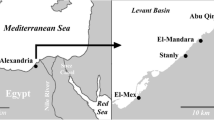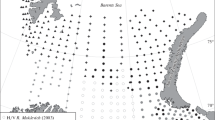Abstract
On the Kolbeinsey Ridge, north of Iceland, 92 species of peracarid crustaceans were sampled using the epibenthic sledge. For an analysis of the multispecies distribution pattern across the ridge, a total of 46 species have been considered, which occurred at least at two stations and with at least 5% relative abundance at any one station. The analysis revealed four assemblages: a deep species assemblage, an eastern slope assemblage, an ubiquitous species assemblage and a western slope assemblage. The western slope assemblage consists mainly of Amphipoda, which were most abundant and diverse on the western slope. The ubiquitous and eastern slope assemblages, however, are dominated by Isopoda, which also comprised most species and individuals on the eastern slope. Cumaceans were the most representative species of the deep species assemblage. These differences in species composition and abundance can probably be attributed to food supply and sediment composition, rather than to salinity or bottom water temperature.
Similar content being viewed by others
References
Altenbach AV, Sarnthein M (1989) Productivity records in benthic Foraminifera. In: Berger WH, Smetacek VS and Wefer G (eds), Productivity of the Oceans: Present and Past, John Wiley and Sons, New York, 255–279
Barnard JL, Karaman GS (1991) The families and genera of marine gammaridean Amphipoda (except marine gammaroids) Part 1 and 2. Rec Aust Mus Suppl 13 (1/2):1–866
Barnes, RD (1987) Invertebrate Zoology. Saunders College Publications (fifth edition), Philadelphia, New York, 1–893
Birgisdottir L (1991) Die paläo-ozeanographische Entwicklung der Islandsee in den letzten 550000 Jahren. Ber Sonderforschungsbereich 313, 34:1–112
Brandt A (1993) Composition, abundance, and diversity of peracarid crustaceans from the Kolbeinsey Ridge, north of Iceland. Polar Biol (in press)
Brattegard T, Fosså JH (1991) Replicability of an epibenthic sampler J mar biol Ass UK 71:153–166
Bray JR, Curtis, JT (1957) An ordination of the upland forest of Southern Wisconsin. Ecol Monogr 27:225–349
Brusca RC, Brusca GL (1990) Invertebrates. Sinauer, Inc. Publishers, Sunderland, Massachusetts, 1–922
Buhl-Jensen L (1986) The benthic amphipod fauna of the WestNorwegian continental shelf compared with the fauna of five adjacent fjords. Sarsia 71:193–208
Carey AG (1991) Ecology of the North American Arctic continental shelf benthos: a review. Continent Shelf Res 11 (8–10):865–883
Coleman ChO (1989a) On the nutrition of two Antarctic Acanthonotozomatidae (Crustacea: Amphipoda). Polar Biol 9:287–294
Coleman ChO (1989b) Gnathiphimedia mandibularis KH Barnard, 1930, an Antarctic amphipod (Acanthonotozomatidae, Crustacea) feeding on Bryozoa. Antarctic Science (short note) 1 (4):343–344
Coleman, ChO (1990a) Bathypanoploea schellenbergi Holman & Watling, 1983, an Antarctic amphipod (Crustacea) feeding on Holothuroidea Ophelia 31 (3):197–205
Coleman, ChO (1990b) Anatomy of the alimentary canal of Parandania boecki (Stebbing, 1888) (Crustacea, Amphipoda, Stegocephalidae) from the Antarctic Ocean. J. Nat Hist 24:1573–1585
Coleman ChO (1991) Comparative fore-gut morphology of Antarctic Amphipoda (Crustacea) adapted to different food sources. Hydrobiol 223:1–9
Dayton PK, Hessler RR (1972) Role of biological disturbance in maintaining diversity in the deep sea. Deep-Sea Res 19:199–208
DeBroyer C, Klages M (1990) Studies on amphipod biology. In: Arntz W, Ernst W, Hempel I (eds). The expedition Antarktis VII/4 (Epos leg 3) VII/5 of RV “Polarstern” in 1989. Ber Polarforsch 68:113–115
Field JG, Clarke K, Warwick RM (1982) A practical strategy for analysing multispecies distribution patterns. Mar Ecol Progr Ser 8:37–52
Graf G (1989) Benthic-pelagic coupling in a deep-sea benthic community. Nature (London) 341:437–439
Graf G (1992) Benthic-pelagic coupling: A benthic view. Oceanogr Mar Biol Annu Rev 30:149–190
Graf G, Linke P (1992) Adenosine nucleotides as indicator of deepsea benthic metabolism. In: deep-sea food chains and global carbon cycle, ed by GT Rowe, NATO ASI Series, Kluwer Acad Publ Dordrecht 237–243
Grassle JF, Maciolek NJ (1992) Deep-sea species richness: regional and local diversity estimates from quantitative bottom samples. Am Nat 139:313–341
Grassle JF, Sanders HL (1973) Life histories and the role of disturbance. Deep-Sea Res 20:643–659
Grebmeier JM, McRoy, CP, Feder HM (1988) Pelagic-benthic coupling on the shelf of the northern Bering and Chukchi Seas. I. Food supply source and benthic biomass. Mar Ecol Progr Ser 48:57–67
Hebbeln D, Wefer G (1991) Effects of ice coverage and ice-rafted material on sedimentation in the Farm Strait. Nature 350 (6317):409–411
Hempel G (1985) On the biology of polar seas, particularly the Southern Ocean. In: Gray JS, Christiansen ME (eds) Marine Biology of Polar Regions and the Effects of Stress on Marine Organisms. John Wiley & Son, Chichester pp 3–34
Henrich R, Kassens H, Vogelsang E, Thiede J (1989) Sedimentary facies of glacial/interglacial cycles in the Norwegian Sea during the last 350 ky′. Mar Geol 86:283–319
Hessler RR, Sanders HL (1967) Faunal diversity in the deep sea. Deep-Sea Res 14:65–78
Jumars PA (1976) Deep-sea species diversity: does it have a characteristic scale? J Mar Res 34:217–246
Jumars PA, Gallagher, ED (1982) Deep-sea community structure: three plays on the benthic proscenium. In: WG Ernst, Morin JG (eds), The environment of the deep sea. Prentice Hall, New Jersey, pp 218–255
Kruskal, JB, Wish, M (1983) Multidimensional scaling -Sage Publications, Beverly Hills, California
Lackschewitz KS (1991) Sedimentationsprozesse am aktiven mittelozeanischen Kolbeinsey Rücken (Nördlich von Island). Geomar Rep 1–133
Lackschewitz KS, Wallrabe-Adams HJ (1991) Composition and origin of sediments on the mid-oceanic Kolbeinsey Ridge, north of Iceland. Mar Geol 101:71–82
Lackschewitz KS, Oehmig R, Wallrabe-Adams HJ (1990) Der aktive mittelozeanische Rücken als Sedimentationsraum — Zusammen-setzung und Dynamik der Sedimente am Kolbeinsey-Rücken (N'Island). Zbl Geol Paläont I(11):1727–1738
Lampitt RS, Billett DSM, Rice AL (1986) Biomass of the invertebrate megabenthos from 500 to 4100 m in the northeast Atlantic Ocean. Mar Biol 93:69–81
Locker, S, Bohlen T, Brunssen, B, Jung, S. Kohly, A, Struck, U (1993) Analysis of sediment sections and preliminary palaeoceanographic results. Norwegian, Greenland, and Iceland Seas. Meteor Berichte (in press)
Machoczek D (1989) Untersuchungen historischer hydrographischer Daten des Europäischen Nordmeeres im Hinblick auf moderne Vorstellungen zur Wassermassenbildung und Zirkulation. DHI, Wiss Tech Ber, pp 1–77
Mauchline J (1980) The biology of mysids and euphausiids (Part Two: The biology of Euphausiids) Adv in Mar Biol 18:1–681
McCloskey LR (1970) The dynamics of the community associated with a marine scleractinian coral. Int Rev Ges Hydrobiol 55:13–81
Moore PG, Rainbow PS (1992) Aspects of the biology of iron, copper and other metals in relation to feeding in Andaniexis abyssi, with notes on Andaniopsis nordlandica and Stegocephalus inflatus (Amphipoda, Stegocephalidae), from Norwegian waters. Sarsia 76:215–225
Oehmig R, Wallrabe-Adams HJ (1993) Hydrodynamic properties and grain-size characteristics of volcaniclastic deposits on the Mid-Atlantic Ridge north of Iceland (Kolbeinsey Ridge). J Sed Petrol 63(1):140–151
Paetsch H, Botz R, Scholten JC, Stoffers P (1992) Accumulation rates of surface sediments in the Norwegian-Greenland Sea. Mar Geol 104:19–30
Piepenburg D (1988) Zur Zusammensetzung der Bodenfauna in der westlichen Fram-Straße. Ber Polarforsch 52:1–118
Piepenburg D, Piatkowski U (1992) A program for computer-aided analyses of ecological field data. CABIOS 8 (6):587–590
Romesburg, CH (1984) Cluster analysis for researchers. Wadsworth, Belmont
Rothlishberg PC, Pearcy WG (1977) An epibenthic sampler used to study the ontogeny of vertical migration of Pandalus jordani (Decapoda, Caridea). Fish Bull 74:994–997
Sanders HL, Hessler RR, Hampson GR (1965) An introduction to the study of deep-sea benthic faunal assemblages along the Gay Head-Bermuda Transect. Deep-Sea Res 12:845–867
Shannon CE, Weaver W (1949) The mathematical theory of communication. University of Illinois Press, Urbana
Smith CR, Hamilton SC (1988) Epibenthic megafauna of the bathyal basin off southern California: patterns of abundance, biomass, and dispersion. Deep-Sea Res 30 (9A):907–928
Suess E (1980) Paniculate organic carbon flux in the oceans-surface productivity and oxygen utilization Nature 288:260–265
Svavarsson, J (1988) Bathyal and abyssal Asellota (Crustacea, Isopoda) from the Norwegian, Greenland, and North Polar Seas. Sarsia 73:83–106
Svavarsson J, Brattegard T, Strömberg J-O (1990) Distribution and diversity patterns of asellote isopods (Crustacea) in the deep Norwegian and Greenland Seas. Prog Oceanog Vol 24:297–310
Svavarsson J, Gudmundsson G, Brattegard T (1993) Feeding by asellote isopods (Crustacea) on foraminifers (Protozoa) in the deep sea. Deep-Sea Res (in press)
Thiede J, Diesen GW, Knudsen BE, Snare T (1986) Patterns of cenozoic sedimentation in the Norwegian-Greenland Sea. Mar Geol 69:323–352
Wainrigth SC (1990) Sediment-to-water fluxes of particulate material and microbes by resuspension and their contribution to the planktonic food web. Mar Ecol Progr Ser 62:271–281
Watling L (1979) Marine Flora and Fauna of the Northeastern United States Crustacea: Cumacea. NOAA Technical Report NMFS Circular 423:1–22
Wilkinson, L (1987) Systat: The system for statistics. Systat Inc., Evanston.
Wilson GDF, Hessler RR (1987): Speciation in the deep sea. Ann Rev Ecol Syst 18:185–207
Wilson GDF, Thistle D (1985) Amuletta, a new genus for Ilyarachna abyssorum Richardson, 1911 (Isopoda: Asellota: Eurycopidae). J Crust Biol 5:350–360
Wolff, T (1962) The systematics and biology of bathyal and abyssal Asellota. Galathea Report 6:1–320
Author information
Authors and Affiliations
Rights and permissions
About this article
Cite this article
Brandt, A., Piepenburg, D. Peracarid crustacean assemblages of the Kolbeinsey Ridge, north of Iceland. Polar Biol 14, 97–105 (1994). https://doi.org/10.1007/BF00234971
Received:
Accepted:
Issue Date:
DOI: https://doi.org/10.1007/BF00234971




